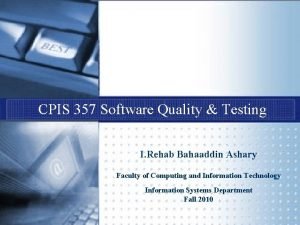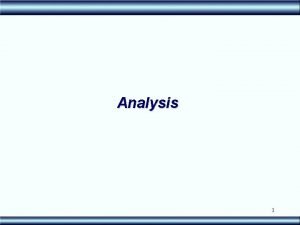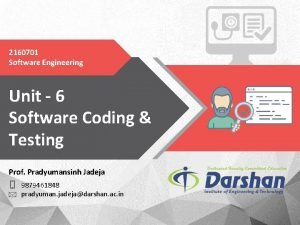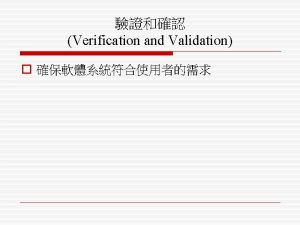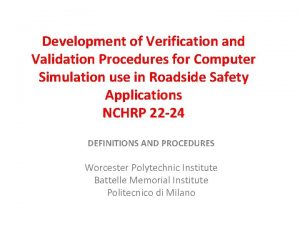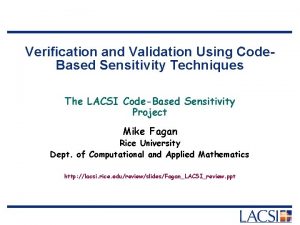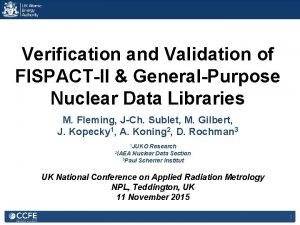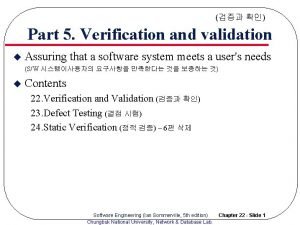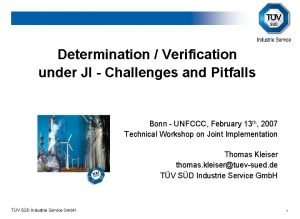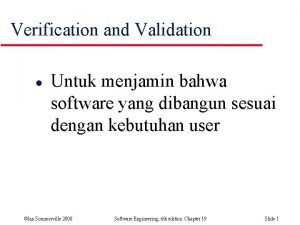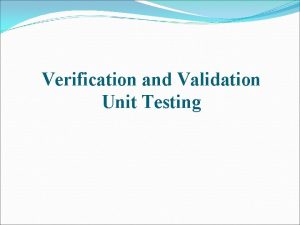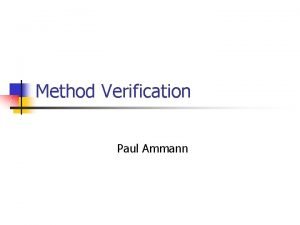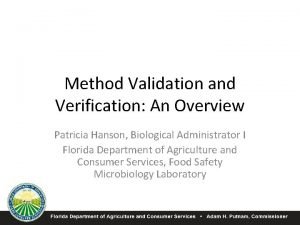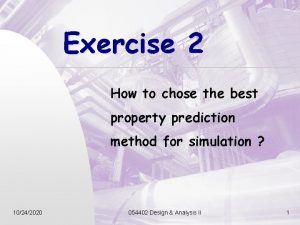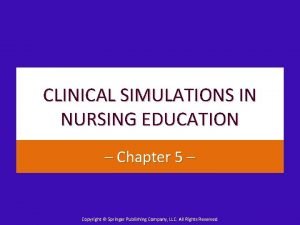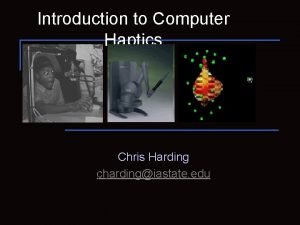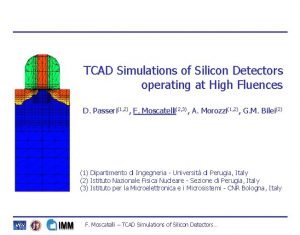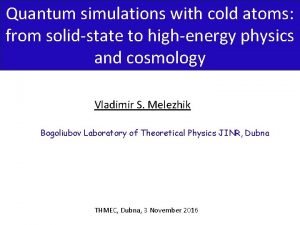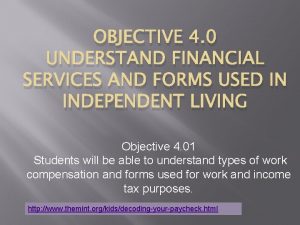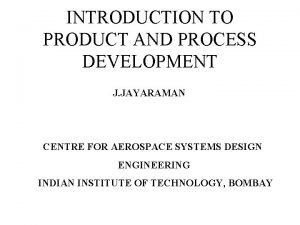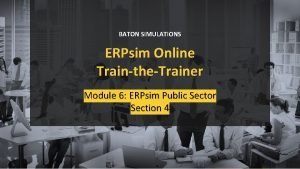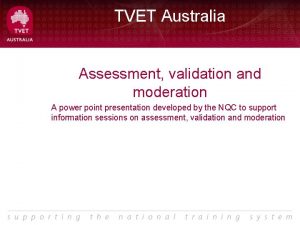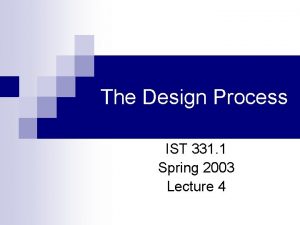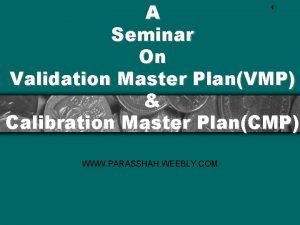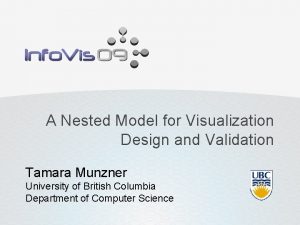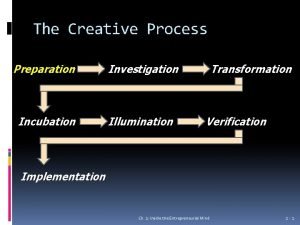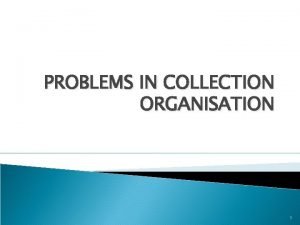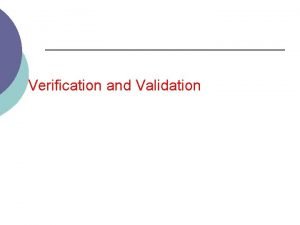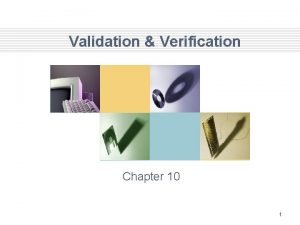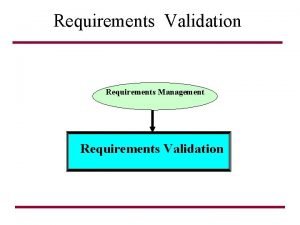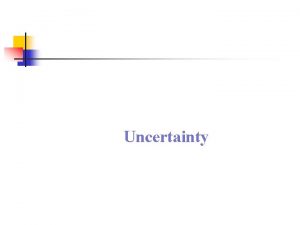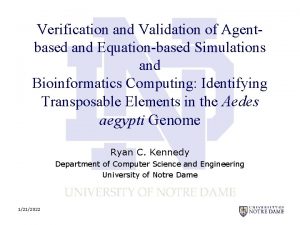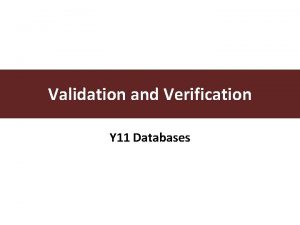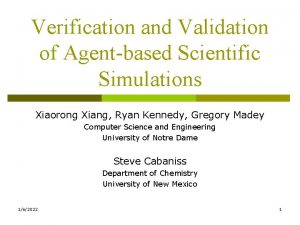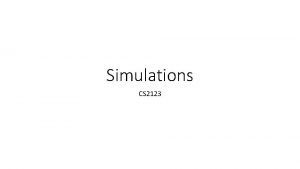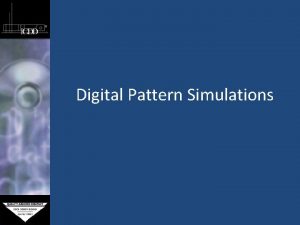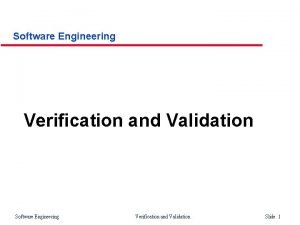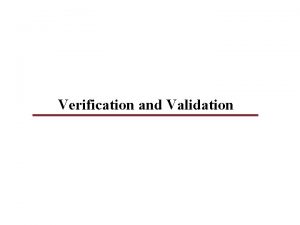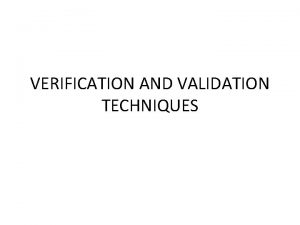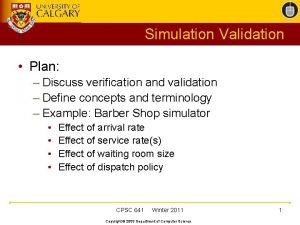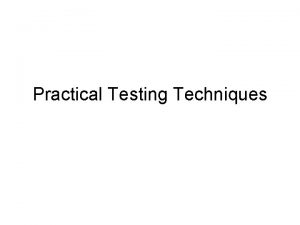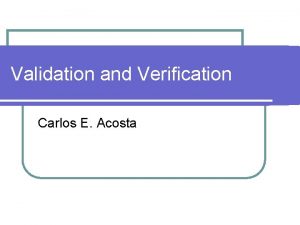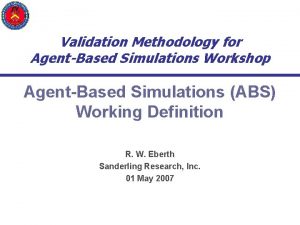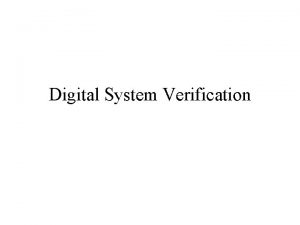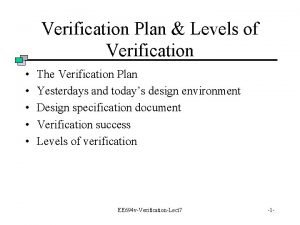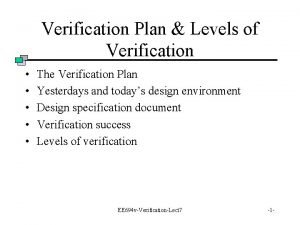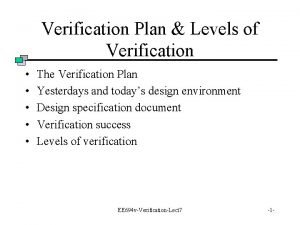Verification and Validation VV of Simulations Uncertainty Analysis






























- Slides: 30

Verification and Validation (V&V) of Simulations (Uncertainty Analysis) Validation: “doing the right thing” Verification: “doing things right” 1

Suppose we have a simulation result. How good is it? The Verification and Validation (V&V) Process can provide a quantitative answer to that question. Consider the comparison between a simulation result and experimental data….

The perspective changes when one begins to consider the uncertainties involved… • The uncertainties determine – the scale at which meaningful comparisons can be made – the lowest level of validation which is possible; i. e. , the “noise level” Thus, the uncertainties in the data and the uncertainties in the simulation must be considered if meaningful conclusions are to be drawn. 3

Definitions for Validation “Doing the right thing” S value from the simulation D data value from experiment E comparison error E = D - S 4

Validation Comparison of Simulation Results with Experimental Results 5

Uncertainty (Error) Definitions • The error S in the simulation is composed of – errors SN due to the simulation’s numerical solution of the equations – errors SPD due to the use of simulation of previous experimental data (properties, etc. ) – errors SMA due to simulation modeling assumptions S = SN + SPD + SMA • Therefore, the comparison error E can be written as E = D - S or E = D - SN - SPD - SMA (A primary objective of a validation effort is to assess the simulation modeling error SMA. )

• Consider the error equation E = D - SN - SPD - SMA • When we don’t know the value of an error i, we estimate an uncertainty interval Ui that bounds i and then work with uncertainties rather than with errors. • The uncertainty interval UE which bounds the comparison error E = DS is given by (assuming no correlations among the errors) or (UE)2 = (UD)2 + (USN)2 + (USPD)2 + (USMA)2 7

(UE)2 = (UD)2 + (USN)2 + (USPD)2 + (USMA)2 • UD can be estimated using well-accepted experimental uncertainty analysis techniques • The estimation of USN is the objective of verification, typically involves grid convergence studies, etc, and is currently an active research area. • To estimate USPD for a case in which the simulation uses previous (input) data di for m variables where the Udi are the uncertainties associated with the input data. • However, we know of no a priori approach for estimating USMA -- in fact, a primary objective of a validation effort is to assess USMA (or SMA) through comparison of the simulation prediction and benchmark experimental data.

(UE)2 = (UD)2 + (USN)2 + (USPD)2 + (USMA)2 • So, we define a validation uncertainty UVAL given by (UVAL)2 = (UE)2 - (USMA)2 = (UD)2 + (USN)2 + (USPD)2 • UVAL is the key metric in this validation approach – it is the “noise level” imposed by the experimental and numerical solution uncertainties; – If SMA = 0, then UVAL would contain the resultant of all of the other errors (E) 95 times out of 100 – thus, UVAL is the tightest (lowest, best) level of validation possible (i. e. , it is “the best that can be done” considering the existing uncertainties)

• If |E | UVAL, then the level of validation is equal to UVAL. • If |E | > UVAL , the level of validation is equal to |E | • If |E | » UVAL , the level of validation is equal to |E | and one can argue that probably SMA E since the interval UVAL should contain the resultant of all errors except SMA (that is, D - SN - SPD ). • The other important metric is the required level of validation, Ureqd, which is set by program objectives.

Schematic of Verification and Validation of a Simulation 11

Types of Uncertainty Analysis • Monte Carlo (MC) • First Order Taylor Series (FOTS) • Univariate Dimension Reduction (UDR or DR) (an additive decomposition technique that evaluates the multidimensional integral of a random function by solving a series of one-dimensional integrals) • Extended Generalized Lambda Distribution (EGLD) (probability distribution function) • Random Field Uncertainty Propagation • Karhunen-Loeve Expansion of Random Field

To develop and quantify uncertainty related to material heterogeneities K. N. Solanki , M. F. Horstemeyer, W. G. Steele, Y. Hammi, J. B. Jordon, Calibration, validation, and verification including uncertainty of a physically motivated internal state variable plasticity and damage model, ” International Journal of Solids and Structures, Vol. 47, 186– 203, 2010.

Uncertainty Methodology Uncertainty in engineering systems Extrinsic Experimental setup Sensor errors Surroundings Intrinsic Modeling Constitutive relations Underlying physics Surroundings Parametric Boundary conditions Process parameters Experiments Modeling/Simulations

Experimental Uncertainty in experimentally measure quantities (force and strain) is give by where , is random uncertainty , is systematic uncertainty Coleman and Steele, 1999

Experimental Uncertainty • Random uncertainty in experimentally measure quantities , (force and strain) for M different tests is give by • Systematic uncertainty in experimentally measure quantities , (force and strain) for M different tests is give by Coleman and Steele, 1999

Experimental Uncertainty Measured Quantities • Force and Strain • Specimen Size (width and Thickness)

Experimental Uncertainty in true stress and true strain is given by where F, is measured force w, is width of specimen t, is thickness of specimen e, is engineering strain

Model Calibration Example Under Uncertainty ± 9. 75% ± 8. 1% ± 7. 0%

Model Validation Example Under Uncertainty tension followed by compression followed by tension

SUMMARY: The V&V Process • Preparation – Specification of validation variables, validation set points, validation levels required, etc. (This specification determines the resource commitment that is necessary. ) – It is critical for modelers and experimentalists to work together in this phase. • Verification – Are the equations solved correctly? (Grid convergence studies, etc, to estimate USN. ) • Validation – Are the correct equations being solved? (Compare with experimental data and attempt to assess SMA )

Uncertainty Quantification and Propagation Objective – Forward propagation of uncertainties from basic sources to system response, R • Experimental Uncertainty Analysis: [Coleman & Steele 1999] X = {X 1, X 2, …, XN}T = Vector of random variables; R = R{X} = Random response expanded uncertainty random standard uncertainty systematic standard uncertainty due to elemental sources of uncertainty affecting Xk due to correlated error in Xk and Xl variance of Xk No prior probability distribution is required in this approach. • Probabilistic Approach: [Sundararajan 1995] = uncertainty in R Given the probability density function (PDF) of random variables (Xk, k=1, N) f. X 3 f. X 2 (for independent random variables) Based on first-order Taylor series approximation of R x 1

Uncertainty Quantification and Propagation (cont) • Given the probability density function (PDF) of each random variable, find uncertainty (st. deviation) in response R as [Sundararajan 1995] f. X 3 PDF of Xk, k=1, N ( for independent random variables) f. X 2 • x 1 Dimension Reduction + Distribution Fitting (DR+EGLD): X = {X 1, X 2, …, XN}T = Vector of random variables; R = R{X} = random response Step 1: Use the Univariate Dimension Reduction approach [Rahman & Xu 2004] to estimate the lth statistical moment, ml of response R based on ml of individual random variables Step 2: Match the approximate statistical moments of R with those of the extended generalized Lambda distribution to find the fitting parameters => more complete description of random uncertainty in R Acar, E. , Rais-Rohani, M. , and Eamon, C. , “Structural Reliability Analysis using Dimension Reduction and Extended Generalized Lambda Distribution, ” International Journal of Reliability and Safety, Vol. 4, Nos. 2/3, 2010, pp. 166 -187.

Uncertainty Quantification and Propagation (Example) Objective – Forward propagation of uncertainties from basic sources to system response, R • Dimension Reduction + Distribution Fitting: [Acar, Rais-Rohani & Eamon 2008] Step 1: Using the Dimension Reduction Approach [Rahman & Xu 2004], estimate the lth statistical moment, ml (e. g. , mean, variance, etc. ) of response R based on ml of individual random variables => Exact multidimensional integral approximated by multiple one-dimensional (simple) integrals Step 2: Match the approximate statistical moments of R with those of an appropriate distribution function (e. g. , EGLD - Extended Generalized Lambda Distribution) to find the fitting parameters. => More complete description (i. e. , PDF) of stochastic uncertainty in R Uncertainty in damage-strain data Example: Determine the stochastic uncertainty in the damage response A 356 Tensile Specimen Uncertainty in model constants ISV-Damage Constitutive Model Damage Uncertainty in microstructure = 0. 001/s Normalized damage sensitivities = 0. 001 Uncertainty in damage Strain Initial radius Nucleation coeff. = 0. 05 Initial temp = 0. 001 Collaborative effort between Tasks 1 and 4: [Acar, Solanki, Rais-Rohani & Horstemeyer 2008] Fracture toughness Coalescence coeff.

Uncertainty and Sensitivity Analysis of Damage • Use DR+EGLD to estimate the uncertainty in damage based on uncertainties in microstructure features (e. g. , void size, particle size, etc. ) found in AA 356 -T 6 cast. @ = 0. 005 @ = 0. 05 Initial temperature Coalescence coefficient @ = 0. 005 Fracture toughness ISV based plasticitydamage => model Initial temperature Coalescence coefficient @ = 0. 05 Strain, Acar, E. , Solanki, K. , Rais-Rohani, M. , and Horstemeyer, M. , “Stochastic Uncertainty Analysis of Damage Evolution Computed Through Microstructure-Property Relations, ” Journal of Probabilistic Mechanics, Vol. 25, No. 2, 2010, pp. 198 -205.

Uncertainty Analysis Example: Damage using DR+EGLD Uncertainty Estimation Comparison of Uncertainty Analysis Results A 356 aluminum tensile specimen, strain rate controlled test • First order Taylor-series (FOTS) expansion Standard deviation of damage • Needs derivatives of response, Y • Feasible for simple problems (numerical derivatives for complex problems) • May fail for mildly nonlinear probs. Strain level 0. 001 0. 02 0. 05 FOTS 2. 4 10 -7 7. 3 10 -4 3. 1 10 -3 DR 2. 4 10 -7 6. 9 10 -4 3. 0 10 -3 MCS with 2. 4 10 -7 6. 9 10 -4 3. 0 10 -3 104 sample An analytical example: Find standard deviation in Y(X) based on that of X. • DR more accurate than FOTS • DR much less costly than MCS Damage Probability Distribution using EGLD A 356 aluminum tensile specimen, strain rate controlled test Based on reducing multi-dimensional integrals to a series of one-dimensional integrals (Rahman & Xu 2004) Using binomial formula @ Strain = 0. 02 Damage Var. Y = m 2 - m 12 PDF Dimension Reduction Techniques Strain to be calculated recursively Damage

Rationale for Probabilistic (Reliability-Based) Design More meaningful to say “Structural design has a Pf = 10 -4 under the extreme loading condition, ” than to say it has a factor of safety of 2 [Wirsching 1992]. • Explicit inclusion of statistical data into the design algorithm. • Quantify the effect of each stochastic uncertainty on the final design. • For a limit state expressed in terms of strength (resistance) R and load L PDF • Limit state function: b = Reliability index L Failure probability: • Exact solution by integration not practical • Estimate Pf or b using fg(r, l) Failure Probability – Simulation Techniques (e. g. , Monte Carlo) Excellent accuracy, Inefficient 0 x For Pf = 0. 001 with 20% error at 95% confidence, Ns = 100, 000! – Analytical Techniques ---> Mixed accuracy, Efficient – Advanced Techniques ---> Good accuracy, Mixed efficiency r, l

Hybrid Uncertainty Approach Related to Structural Reliability Limit state: Structural Reliability Methods: – – Simulation (MCS, LH, IS, AIS) Analytical (FORM, SORM, AMV+) Reliability index: b PDF • L Failure Probability – Hybrid methods under development: • Dimension Reduction + EGLD (Acar et al. 2008) • Full Failure Sampling (Eamon & Charumas 2008) fg(R, L) 0 x Most Probable Point, MPP Acar, E. , Rais-Rohani, M. , and Eamon, C. , “Reliability Estimation using Dimension Reduction and Extended Generalized Lambda Distribution, ” submitted to International Journal of Reliability and Safety, 2008.

SUMMARY: The V&V Process • Preparation – Specification of validation variables, validation set points, validation levels required, etc. (This specification determines the resource commitment that is necessary. ) – It is critical for modelers and experimentalists to work together in this phase. • Verification – Are the equations solved correctly? (Grid convergence studies, etc, to estimate USN. ) • Validation – Are the correct equations being solved? (Compare with experimental data and attempt to assess SMA )

Some Selected References • Coleman, H. W. and Stern, F. , "Uncertainties in CFD Code Validation, " ASME J. Fluids Eng. , Vol. 119, pp. 795 -803, Dec. 1997. (See also Roache, P. J, “Discussion” and Coleman and Stern, “Authors’ Closure, ” ASME J. Fluids Eng. , Vol. 120, pp. 635 -636, Sept. 1998. ) • Roache, P. J. , Verification and Validation in Computational Science and Engineering, Hermosa, 1998. (www. hermosa-pub. com) • Guide for the Verification and Validation of Computational Fluid Dynamics Solutions, AIAA Guide G-077 -1998, 1998. (www. aiaa. org) • Stern, F. , Wilson, R. V. , Coleman, H. W. , and Paterson, E. G. , “Comprehensive Approach to Verification and Validation of CFD Simulations—Part 1: Methodology and Procedures, ” ASME J. Fluids Eng. , Vol. 123, pp. 793 -802, Dec. 2001. • K. N. Solanki , M. F. Horstemeyer, W. G. Steele, Y. Hammi, J. B. Jordon, Calibration, validation, and verification including uncertainty of a physically motivated internal state variable plasticity and damage model, ” International Journal of Solids and Structures, Vol. 47, 186– 203, 2010. 30
 Verification and validation
Verification and validation Verification and validation
Verification and validation Coding and testing in software engineering
Coding and testing in software engineering Verification and validation plan
Verification and validation plan Asme v&v 10
Asme v&v 10 Verification and validation
Verification and validation Verification and validation
Verification and validation Verification and validation plan
Verification and validation plan Verification and validation
Verification and validation A software verification and validation method. section 19
A software verification and validation method. section 19 Software verification and validation plan
Software verification and validation plan Is unit testing verification or validation
Is unit testing verification or validation Method verification vs validation
Method verification vs validation Method verification vs validation
Method verification vs validation Don't gamble with physical properties for simulations
Don't gamble with physical properties for simulations Clinical simulations in nursing education
Clinical simulations in nursing education Chris harding simulations
Chris harding simulations Tcad simulations
Tcad simulations World history simulations
World history simulations Simulations for solid state physics
Simulations for solid state physics Payroll card
Payroll card Pinpoint simulations 777
Pinpoint simulations 777 Baton simulations
Baton simulations Validation and moderation templates
Validation and moderation templates Ist spring design and validation
Ist spring design and validation Validation and calibration of master plan
Validation and calibration of master plan Pega express testing and validation
Pega express testing and validation A nested model for visualization design and validation
A nested model for visualization design and validation Investigation in creative process
Investigation in creative process Verification principle strengths and weaknesses
Verification principle strengths and weaknesses Stock rectification in library
Stock rectification in library
